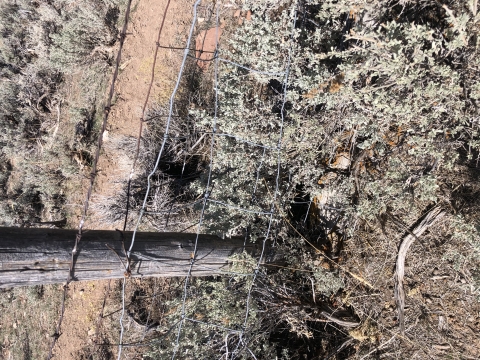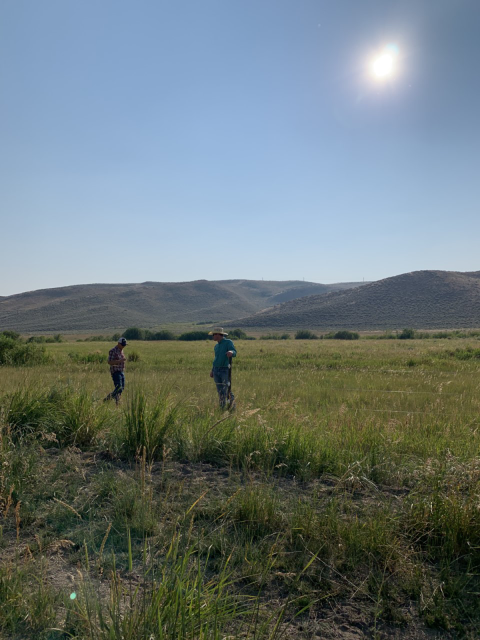We drove up to a large open area covered with specks of white and brown — thousands of them. “Those are antelope,” Idaho Fish and Wildlife Office biologist Matt Bringhurst said. “They are trying to move from Island Park to the Sandcreek desert to over-winter.” The problem is that, right now, they basically become trapped along the Highway 20 corridor because of mesh-wire fences that run along each side of it, making them very vulnerable to vehicle collisions and being stuck in sub-ideal habitat until they are able to find a break in the fence or a way out.
In 1873, the American West was changed forever with Joseph Glidden’s clever invention — the barbed-wire fence. The word “fence” comes from “fens,” a 14th century word meaning defense. It’s very fitting, given that Glidden’s invention was an intimidating wire, fitted with sharp barbs. Since then, humans have spent more than a century settling the West and fencing neighbors and animals in and out of areas, and in some cases, leaving them for their successors to manage. It’s difficult to imagine the world without fences. They are a homestead-era legacy that defines property, confines pets and livestock, and joins or separates public and private land. For settlers, fences make space into place, but for wildlife, fences limit travel and access to important habitat.
This problem is nothing new to Matt, and it is also something that the Fish and Wildlife Service has acknowledged for many years. In fact, the Department of the Interior even established a Secretarial Order (SO3362) which was signed in November of 2018, to improve habitat quality in western big-game winter range and migration habitats. The purpose of SO3362 is not restricted to addressing fencing issues, it is more broad and asks the Department of the Interior agencies “to enhance and improve the quality of big-game winter range and migration corridor habitat on Federal lands…in a way that recognizes state authority to conserve and manage big-game species and respects private property rights.” In Idaho, however, the fencing issues rises to the top as something that is commonly having a negative effect on big game. That’s why Matt and his partners put their heads together to come up with ways to successfully help big-game in Idaho with small projects, that all together, pack a big punch.
Flat Ranch
In the Greater Yellowstone Area, at the headwaters of the Henry’s Fork River, is one of the largest intact ecosystems in the country. Because of the area’s value to wildlife and rich biodiversity, it is no surprise that many stakeholders have land ownership and/or a deep interest in the area’s preservation. Much of the area is a working landscape and used for cattle ranching. In fact the Idaho Department of Lands, The Idaho Department of Fish and Game (IDFG), and the Nature Conservancy all work cooperatively with local ranchers to promote and maintain grazing operations that are good for the ranchers and beneficial for big game and other wildlife.
The Idaho Fish and Wildlife Office’s (IFWO) Partners for Fish and Wildlife Program became interested in the area when it recognized that antelope were getting caught up by fences along Highway 20. For the Flat Ranch Project, the fences are still needed for the cattle allotments to be successful, so the partners worked together to plan for a wildlife friendly fence installation. The existing fence was too high and contained barbs on the bottom and top. This configuration doesn’t allow for wildlife to jump over the fence or move under the fence safely, causing antelope and elk calves to get stuck. The solution was to replace the fence with one that is lower height and smooth wire on the bottom, allowing antelope to go under and elk to pass over. This way, big game can easily pass the fence and continue on their migration to their fawning and summer habitat areas. Because of the thoughtful planning that went into fence management at Flat Ranch, this project was a win-win for big game, the livestock permittees, and the many partners.
Sand Creek Fence Project
In 2018, northwest of St Anthony, Idaho, the Grassy Ridge Fire burned over 100,000 acres that left elk winter range and some of the highest quality sage grouse habitat in Idaho charred black. During post fire recovery efforts, a 13-mile fence project was identified. The fence had two strands of barbed wire above a 48-inch mesh wire fence panel that resulted in a fence height of 52 to 60-inches high. The height of the fence was difficult for elk and moose to leap over and was a complete barrier to antelope, ungulate fawns, and calves. The project location is within “transitional habitat” where elk, moose, and mule deer migrate from as far as Yellowstone National Park and the Montana border to the Sand Creek desert. IDFG mapped elk movement data and identified a priority , 3-mile portion of the legacy fence to be removed (southeast of Kilgore).
Because the Bureau of Land Management (BLM) and the State of Idaho all have livestock permittees grazing cattle in the area, it was determined that a wildlife friendly fence was the best solution. Furthermore, these allotments were converted from sheep to cattle, changing the fence needs such that mesh wire was no longer necessary.
It took many partners to accomplish the 3 miles of fence removal and upgrades east of Kilgore, and they include the Greater Yellowstone Coalition, IDFG, the BLM, the Natural Resource Conservation Service, the Idaho Fish and Wildlife Foundation, and the U.S. Forest Service, and together with the IFWO, these partners helped financially and also through the planning and implementation phases.
Market Lake Project
The IDFG’s 6,062 acre Market Lake Wildlife Management area near Hamer, Idaho is primarily managed for waterfowl, but it turns out it’s great habitat for antelope and elk as well. In order to make improvements for big game, the Habitat Manager pursued a fence removal project to remove a 7-wire fence that was nearly impassable to big game. The IFWO worked together with IDFG to use a piece of equipment called a skid-steer for the fence removal. This machine, which looks similar to a mini-dozer, has a wire roller and fence removal tool attached and allows one person to operate it and remove unwanted fence efficiently. Because Market Lake is a migration priority for big game, removing this fence will allow deer, elk, and antelope to better access and thrive in the area.
Rinker Rock Creek Ranch
The University of Idaho’s Rinker Rock Creek Ranch, near Hailey, Idaho, is a unique working ranch which also serves as an education, research, and outreach facility. This is also a place where science-based practices for land managers are developed. Along with IDFG, University of Idaho, the Wood River Land Trust, The Nature Conservancy, and First Lite, the IFWO has collaborated with the University of Idaho on many projects to benefit wildlife and grazing operations alike. The 10,400-acre ranch has a diversity of habitats that support a wide-range of wildlife from big game to greater sage-grouse. It was therefore, no surprise that all of these partners put their minds together to design and implement a fence improvement project under the Secretarial Order 3362.
When the University took over management of the ranch in the 2010s, they determined that their livestock could use larger pastures and less fence with the addition of regular herding. Over the past few years, the ranch has removed, replaced, and modified dozens of miles of fences to improve livestock management between riparian riparian
Definition of riparian habitat or riparian areas.
Learn more about riparian and upland habitats. They also inventoried and removed all fences that were not relevant to current management and installed 3-strand let-down fences that are only needed seasonally. The Idaho Partners for Fish and Wildlife Program joined these partners to roll and extract approximately 13 miles of un-needed fencing (largely homestead era netted & barbed wire) that was an impediment to wildlife movements on the Ranch.
These projects are each fairly small, when you consider the threat to big game throughout the West, but Matt and his partners have a big sense of accomplishment for what’s been done in Idaho to date. “When you see the road mortalities go down and witness antelope moving right through areas that were previously blocked, that’s when you know that we’ve made a difference,” Matt said. The key to getting this work done on the ground and future projects planned “really comes down to the partnerships,” Matt explained. “We all figure out the problem areas together, based on data, and then work together on every step, from planning to implementation.” Little has been done to change fence technology in the last 100 years, but we are facilitating progress for fencing, for both wildlife and livestock producers. This is clearly an example of how working together can result in greater accomplishments than could be accomplished alone. “Just like the big game migrations, animals all move together in groups. The FWS is taking the same approach by moving together, with our partners, to tackle this challenge for big game.”






